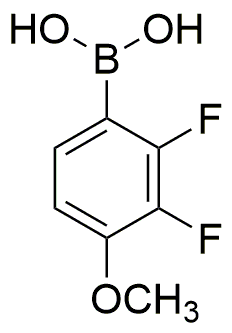2,3-Difluoro-4-methoxyphenylboronic acid is widely utilized in research focused on:
- Pharmaceutical Development: This compound plays a crucial role in the synthesis of various pharmaceuticals, particularly in the development of targeted therapies for cancer treatment, enhancing drug efficacy and specificity.
- Organic Synthesis: It serves as a versatile building block in organic chemistry, facilitating the creation of complex molecules through cross-coupling reactions, which are essential in the production of agrochemicals and fine chemicals.
- Material Science: Used in the formulation of advanced materials, it contributes to the development of polymers and coatings with improved properties, such as enhanced durability and chemical resistance.
- Bioconjugation: This compound is valuable in bioconjugation techniques, allowing researchers to attach biomolecules to surfaces or other molecules, which is vital for diagnostics and therapeutic applications.
- Fluorescent Probes: It can be utilized in the design of fluorescent probes for biological imaging, aiding researchers in visualizing cellular processes and understanding disease mechanisms.
General Information
Properties
Safety and Regulations
Applications
2,3-Difluoro-4-methoxyphenylboronic acid is widely utilized in research focused on:
- Pharmaceutical Development: This compound plays a crucial role in the synthesis of various pharmaceuticals, particularly in the development of targeted therapies for cancer treatment, enhancing drug efficacy and specificity.
- Organic Synthesis: It serves as a versatile building block in organic chemistry, facilitating the creation of complex molecules through cross-coupling reactions, which are essential in the production of agrochemicals and fine chemicals.
- Material Science: Used in the formulation of advanced materials, it contributes to the development of polymers and coatings with improved properties, such as enhanced durability and chemical resistance.
- Bioconjugation: This compound is valuable in bioconjugation techniques, allowing researchers to attach biomolecules to surfaces or other molecules, which is vital for diagnostics and therapeutic applications.
- Fluorescent Probes: It can be utilized in the design of fluorescent probes for biological imaging, aiding researchers in visualizing cellular processes and understanding disease mechanisms.
Documents
Safety Data Sheets (SDS)
The SDS provides comprehensive safety information on handling, storage, and disposal of the product.
Product Specification (PS)
The PS provides a comprehensive breakdown of the product’s properties, including chemical composition, physical state, purity, and storage requirements. It also details acceptable quality ranges and the product's intended applications.
Certificates of Analysis (COA)
Search for Certificates of Analysis (COA) by entering the products Lot Number. Lot and Batch Numbers can be found on a product’s label following the words ‘Lot’ or ‘Batch’.
*Catalog Number
*Lot Number
Certificates Of Origin (COO)
This COO confirms the country where the product was manufactured, and also details the materials and components used in it and whether it is derived from natural, synthetic, or other specific sources. This certificate may be required for customs, trade, and regulatory compliance.
*Catalog Number
*Lot Number
Safety Data Sheets (SDS)
The SDS provides comprehensive safety information on handling, storage, and disposal of the product.
DownloadProduct Specification (PS)
The PS provides a comprehensive breakdown of the product’s properties, including chemical composition, physical state, purity, and storage requirements. It also details acceptable quality ranges and the product's intended applications.
DownloadCertificates of Analysis (COA)
Search for Certificates of Analysis (COA) by entering the products Lot Number. Lot and Batch Numbers can be found on a product’s label following the words ‘Lot’ or ‘Batch’.
*Catalog Number
*Lot Number
Certificates Of Origin (COO)
This COO confirms the country where the product was manufactured, and also details the materials and components used in it and whether it is derived from natural, synthetic, or other specific sources. This certificate may be required for customs, trade, and regulatory compliance.


